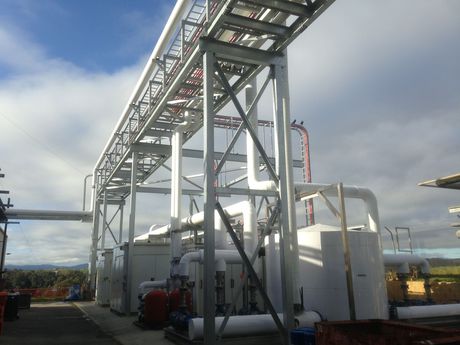Lion cheese keeps its cool with new refrigeration system

A new refrigeration system has proved a vital consideration for Lion as the food and beverage manufacturer has expanded The Heritage cheese factory in Burnie to help supply growing international demand for dairy products.
After decades of organic growth, the latest upgrade of Lion’s north-west Tasmanian factory required a fresh approach to support the company’s aim to double production at the site.
The new plant, designed by leading engineering consultant pitt&sherry, replaces an ageing system that included some components more than 40 years old.
According to pitt&sherry’s senior engineer on the project, John Wylie, “The system had finally outgrown itself” as Lion prepared for the future.
Refrigeration is an important factor in both production processing and cheesemaking. It is required for milk pre-cooling, milk storage and pasteurisation during production processing, and for soft ripened cheese coagulation and pressed cheese brine bath cooling, coolrooms, maturing rooms and climate control during cheesemaking.
The existing refrigeration plant at Burnie comprised three reciprocating compressors, including two Sabroes and a 40-year-old Vilter, as well as two ageing water-cooled evaporative condensers.
The secondary cooling mediums included liquid ammonia for the cool store, pressed cheese maturing, waxing tunnel, drying tunnel and transit coolroom, and two chilled water systems.
“The total rated refrigeration capacity available was less than 25% of the predicted refrigeration load of the new facility,” Wylie noted.

Packaged solution
The initial specification for the new refrigeration system was for a traditional central plant layout, comprising an engine room, evaporative condensers, flooded receiver, compressors, high- and low-temperature accumulators and chilled water storage tank.
However, this option was abandoned in favour of a packaged chiller system after the tender process delivered alternatives.
Despite an energy-efficiency penalty being associated with the packaged chiller system, several advantages were identified following analysis and comparison of both options.
“The packaged system’s advantages were deemed to outweigh the energy-efficiency penalty and a decision to proceed with the packaged refrigeration solution was made,” Wylie recalled.
Packaged advantages
The advantages of a packaged chiller solution included a lower requirement for ammonia charge, noise emissions are contained within each unit, lower capital cost, smaller footprint than a central engine room, engine room building not necessarily required and ease of future upgrades.
In contrast, the lack of room for installation, a requirement for extensive building modifications, and disruption to the existing engine room’s operation drove the decision away from the packaged option.
The trade-off was a slight energy penalty associated with several factors, including higher cooling waters from the ammonia condenser and increased fan airflow, both to the cooling tower.
“In addition, improved part load performance for the central plant option was part of the penalty as the heat exchangers were to run off a single accumulator fed by multiple compressors,” said Wylie.
Another consideration was the coefficient of performance (COP) of the refrigeration plant, traditionally determined purely in terms of compressor efficiency.
Despite compressor COPs not varying between each option, a comprehensive assessment of condenser/cooling tower fans, cooling water pumps and primary/secondary chilled water pumps was undertaken.
Efficiency drive
The next step involved ensuring an energy-efficient outcome without compromising redundancy in the event of compressor failure.
In terms of part load performance, Wylie explained that an oversized compressor would suffer an energy penalty at low loads as co-efficient of performance varies with refrigeration demand and drops off considerably at very low loads.
“This required optimisation of a number of compressors,” Wylie said. “To assist in the decision-making process, an hourly analysis of HVAC loads over a full year was carried out utilising typical meteorological data year (TMY) weather data. This was also added to a timing chart developed for process chilled water loads.”
From this analysis, the number of hours per year at particular demand could be evaluated, and the compressor selection optimised.
Design energy demand
To meet design demand of 2.6 MW, three options were considered, with the final decision on a design incorporating four 700 kW compressors, as well as two 1750 kW cooling towers for heat rejection.
The analysis found that three compressors would service all loads up to the 95th percentile load, while four compressors were needed to service loads above this level. It was predicted that 50 hours per year would be above the 95th percentile.
“If a compressor was lost due to breakdown or maintenance there would be a negligible impact on operations of the plant,” Wylie said.
Part load performance for this option was good, as compressors would progressively shut down to meet lowered demand, and the demand loads matched optimal COPs of each compressor.
The analysis showed that for 1500 hours per year, the refrigeration load would be around 100 kW - suited to one 700 kW compressor, and for 2000 hours per year the load would be around 1000 kW - suited to two 700 kW compressors.
In addition to the compressors, other energy-efficiency measures adopted included use of variable frequency drives (VFDs) on the secondary chilled water pumps and the cooling tower fans.
Resource-saving greenfield brewery being built in Germany
Designed with a 500,000 hectolitres/year capacity, a greenfield brewery is being constructed by...
Mars Wrigley Australia invests $6.5m to expand capacity at its Asquith factory
A new production line and circular-by-design packing technology have been introduced at the...
In good spirits: SRD's plans to transform iconic Oak factory site
On 21 March, at the historic former Oak factory site in Muswellbrook, Sydney Rum Distillery (SRD)...














